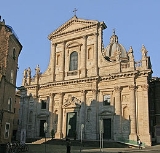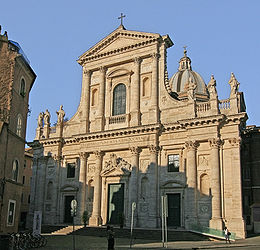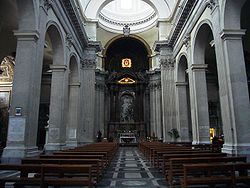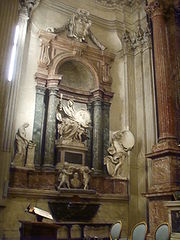
San Giovanni dei Fiorentini
Encyclopedia

Ponte (rione of Rome)
Ponte is the fifth rione of Rome. Its name comes from Ponte Sant'Angelo, which connects Ponte with the rione of Borgo. This bridge was built by Emperor Hadrian in 134 AD to connect his mausoleum to the rest of the city...
rione
Rioni of Rome
A rione is an Italian term used since the Middle Ages to name the districts of Rome, according to the administrative divisions of that time. The word originates from the Latin word regio A rione (pl. rioni) is an Italian term used since the Middle Ages to name the districts of Rome, according to...
or district of Rome
Rome
Rome is the capital of Italy and the country's largest and most populated city and comune, with over 2.7 million residents in . The city is located in the central-western portion of the Italian Peninsula, on the Tiber River within the Lazio region of Italy.Rome's history spans two and a half...
. Dedicated to St John the Baptist, the protector of Florence, the new church for the Florentine community in Rome was started in the 16th century and completed in early eighteenth and is the national church of Florence in Rome
National churches in Rome
Charitable institutions attached to churches in Rome were founded right through the medieval period and included hospitals, hostels and others providing assistance to pilgrims to Rome from a certain "nation", which thus became these nations' national churches in Rome...
. The main façade fronts onto the Via Giulia
Via Giulia
Via Giulia is a street in the historic centre of Rome, Italy, mostly in rione Regola, although its northern part belongs to rione Ponte. It was one of the first important urban planning projects in Renaissance Rome....
. This straight street was an urban initiative, carried out in 1508 by the architect Donato Bramante
Donato Bramante
Donato Bramante was an Italian architect, who introduced the Early Renaissance style to Milan and the High Renaissance style to Rome, where his most famous design was St...
at the instigation of Pope Julius II
Pope Julius II
Pope Julius II , nicknamed "The Fearsome Pope" and "The Warrior Pope" , born Giuliano della Rovere, was Pope from 1503 to 1513...
Della Rovere, which cut through the irregular urban fabric to the Ponte Sant’Angelo, the bridge which crosses the River Tiber to the Castel Sant’Angelo and St Peters.
The first projects
It was Julius II’s successor, the Florentine Pope Leo XPope Leo X
Pope Leo X , born Giovanni di Lorenzo de' Medici, was the Pope from 1513 to his death in 1521. He was the last non-priest to be elected Pope. He is known for granting indulgences for those who donated to reconstruct St. Peter's Basilica and his challenging of Martin Luther's 95 Theses...
de Medici, who initiated the architectural competition for a new church in 1518 on the site of the old church of S. Pantaleo. Designs were put forward by prominent architects such as Baldassare Peruzzi
Baldassare Peruzzi
Baldassare Tommaso Peruzzi was an Italian architect and painter, born in a small town near Siena and died in Rome. He worked for many years, beginning in 1520, under Bramante, Raphael, and later Sangallo during the erection of the new St. Peter's...
, Jacopo Sansovino
Jacopo Sansovino
Jacopo d'Antonio Sansovino was an Italian sculptor and architect, known best for his works around the Piazza San Marco in Venice. Andrea Palladio, in the Preface to his Quattro Libri was of the opinion that Sansovino's Biblioteca Marciana was the best building erected since Antiquity...
, Antonio da Sangallo the Younger
Antonio da Sangallo the Younger
thumb|250px|The church of Santa Maria di Loreto near the [[Trajan's Market]] in [[Rome]], considered Sangallo's masterwork.thumb|250px|View of St. Patrick's Well in [[Orvieto]]....
and the painter and architect, Raphael
Raphael
Raffaello Sanzio da Urbino , better known simply as Raphael, was an Italian painter and architect of the High Renaissance. His work is admired for its clarity of form and ease of composition and for its visual achievement of the Neoplatonic ideal of human grandeur...
. The dominant initial ideas were for a centralised church arrangement .
Sansovino, Sangallo the Younger and Michelangelo
Sansovino won the competition but following various difficulties, including the substructure near the river’s edge, Sangallo was put in charge of the building work, made a wooden model and the design was reorganised as a Latin cross plan. Work proceeded slowly. With only some of the nave foundations having been laid by Leo’s death in 1523, construction ground to a halt by the time of the Sack of RomeSack of Rome
The city of Rome has been sacked on several occasions. Among the most famous:*Battle of the Allia – Rome is sacked by the Gauls after the Battle of the Allia*Sack of Rome – Rome is sacked by Alaric, King of the Visigoths...
in 1527.
In 1559, Michelangelo
Michelangelo
Michelangelo di Lodovico Buonarroti Simoni , commonly known as Michelangelo, was an Italian Renaissance painter, sculptor, architect, poet, and engineer who exerted an unparalleled influence on the development of Western art...
was asked by Cosimo I de Medici, Duke of Tuscany, to prepare designs for the church and he presented a centralised church arrangement but this was not adopted .
The church construction: Della Porta, Maderno and Galilei

Giacomo della Porta
Giacomo della Porta was an Italian architect and sculptor, who worked on many important buildings in Rome, including St. Peter's Basilica. He was born at Porlezza, Lombardy and died in Rome.-Biography:...
based on the Latin cross arrangement. Carlo Maderno
Carlo Maderno
Carlo Maderno was a Swiss-Italian architect, born in Ticino, who is remembered as one of the fathers of Baroque architecture. His façades of Santa Susanna, St. Peter's Basilica and Sant'Andrea della Valle were of key importance in the evolution of the Italian Baroque...
took over from 1602-1620 during which time the dome was constructed and the main body of the church completed. However, the main façade onto the Via Giulia was not finished until 1734, based on a design by Alessandro Galilei .
The choir interior: Cortona, Borromini and Ferri
In 1634, the Roman Baroque painter and architect, Pietro da CortonaPietro da Cortona
Pietro da Cortona, by the name of Pietro Berrettini, born Pietro Berrettini da Cortona, was the leading Italian Baroque painter of his time and also one of the key architects in the emergence of Roman Baroque architecture. He was also an important decorator...
, was asked by the Florentine nobleman, Orazio Falconieri
Orazio Falconieri
thumb|300 px|The [[Villa Falconieri]] in Rome; renovations were commissioned by Orazio FalconieriOrazio Falconieri was an Italian nobleman from Florence, Italy and owner of the Villa Falconieri...
, to design the High Altar . Drawings for the altar and its setting and a model were prepared but the project was not carried out. Cortona’s ideas for the choir included windows hidden from the view of the congregation that would illuminate the altarpiece, an early example of the Baroque usage of a ‘hidden light’ source, a concept which would be much employed by Bernini. Some twenty to thirty years later, Falconieri resurrected the choir project but gave the commission to the Baroque architect, Francesco Borromini
Francesco Borromini
Francesco Borromini, byname of Francesco Castelli was an architect from Ticino who, with his contemporaries, Gian Lorenzo Bernini and Pietro da Cortona, was a leading figure in the emergence of Roman Baroque architecture.A keen student of the architecture of Michelangelo and the ruins of...
who changed the design to allow for the burial of Orazio's brother Cardinal Lelio Falconieri
Lelio Falconieri
Lelio Falconieri was an Italian Catholic Cardinal.-Family and early life:Falconieri was born in 1585 in Florence, the tenth of the thirteen children of Paolo Falconieri and his second wife Maddalena degli Albizzi. He was the brother of Don Orazio Falconieri who purchased the Villa Falconieri and...
. After Borromini died in 1667, the work was completed and partly modified by Cortona and on his death in 1669, by Ciro Ferri
Ciro Ferri
Ciro Ferri was an Italian Baroque sculptor and painter, the chief pupil and successor of Pietro da Cortona.He was born in Rome, where he began working under Cortona and with a team of artists in the extensive fresco decorations of the Quirinal Palace...
, Cortona’s pupil and associate .
Given the opportunity that this new church presented, its Florentine patronage and the actual and potential involvement of leading architects and artists of the time, the resultant building is perhaps disappointing.
Interior embellishments and monuments
The choir is the family chapel of the Falconieri family and houses a number of Baroque sculptures. The relief on the High Altar portrays the 'Baptism of Christ' by Antonio RaggiAntonio Raggi
Antonio Raggi , also called Antonio Lombardo, was a sculptor of the Roman Baroque, originating from Ticino.-Biography:He was born in Vico Morcote on the Lake Lugano. His mentor in Rome for nearly three decades was Gianlorenzo Bernini...
. The large altar, made of French red marble and Cottanello marble, is surmounted the figures of 'Justice' by Michel Anguier and Fortitude' by Leonardo Reti. To either side are tombs of the Falconieri family, enriched with stucco and marble portraits of family members in polychrome medallions supported by putti. Statues include 'Faith' by Ercole Ferrata
Ercole Ferrata
Ercole Ferrata was an Italian sculptor of the Roman Baroque.-Biography:A native of Pellio Inferiore, near Como, Ferrata initially apprenticed with Alessandro Algardi, and became one of his prime assistants...
and 'Charity' by Domenico Guidi
Domenico Guidi
Domenico Guidi was a prominent Italian Baroque sculptor.Born in Carrara, Guidi followed his uncle, the prominent sculptor, Giuliano Finelli to Naples. As the nephew of a sculptor noted for his feud with Bernini, it is not surprising that Guidi was never employed by the eminent master...
The neoclassical tomb of Alexander and Marianna Falconieri Lante is by Paolo Benaglia.

Sacchetti
Sacchetti is a surname, and may refer to:* Arturo Sacchetti* Dardano Sacchetti* Francesco Sacchetti* Franco Sacchetti* Ivano Sacchetti* Massimo Sacchetti* Romeo Sacchetti...
family Chapel), which has wall and vault frescoes by Giovanni Lanfranco
Giovanni Lanfranco
Giovanni Lanfranco was an Italian painter of the Baroque period.-Biography:Giovanni Gaspare Lanfranco was born in Parma, the third son of Stefano and Cornelia Lanfranchi, and was placed as a page in the household of Count Orazio Scotti...
and a bronze crucifix created by Paul Sanquirico and made by Prospero Antichi. The left transept accommodates commemorative busts of Antonio Barberini, after Bernini, and of Pietro Francesco De Rossi.
The right transept has a painted Martyrdom of Saints Cosmas and Damian by Salvatore Rosa, a bust of Ottavio Corsini by Alessandro Algardi
Alessandro Algardi
Alessandro Algardi was an Italian high-Baroque sculptor active almost exclusively in Rome, where for the latter decades of his life, he was the major rival of Gian Lorenzo Bernini.-Early years:...
and of Ottaviano Acciaioli by Ercole Ferrata
Ercole Ferrata
Ercole Ferrata was an Italian sculptor of the Roman Baroque.-Biography:A native of Pellio Inferiore, near Como, Ferrata initially apprenticed with Alessandro Algardi, and became one of his prime assistants...
On the pillars of the nave are monuments to Francesca Riccardi Calderini Pecori by Antonio Raggi
Antonio Raggi
Antonio Raggi , also called Antonio Lombardo, was a sculptor of the Roman Baroque, originating from Ticino.-Biography:He was born in Vico Morcote on the Lake Lugano. His mentor in Rome for nearly three decades was Gianlorenzo Bernini...
of circa 1655, to Alessandro Gregorio Capponi, designed by Ferdinando Fuga
Ferdinando Fuga
Ferdinando Fuga was an Italian architect, whose main works were realized in Rome and Naples in the Baroque style.-Biography:Born in Florence, he began to work in that city as a pupil of Giovanni Battista Foggini. In 1717 he moved to Rome, to continue his apprentice studies...
and sculpted in 1746 by Michelangelo Slodtz, a monument to Girolamo Samminiati by Filippo della Valle
Filippo della Valle
Filippo della Valle was an Italian late-Baroque or early Neoclassic sculptor, active mostly in Rome.-Biography:Della Valle was born in Florence....
of 1733, and the bust of Clement XII Corsini.
On the main façade are sculptures by a variety of artists; Filippo della Valle
Filippo della Valle
Filippo della Valle was an Italian late-Baroque or early Neoclassic sculptor, active mostly in Rome.-Biography:Della Valle was born in Florence....
, Paolo Benaglia, Pietro Bracci
Pietro Bracci
Pietro Bracci was an Italian sculptor working in the Late Baroque manner.-Biography:He was born in Rome and became a student of Giuseppe Bartolomeo Chiari and Camillo Rusconi...
, Domenico Scaramuccia, Salvatore Sanni], Francesco Queirolo
Francesco Queirolo
Francesco Queirolo was an Italian Genoese-born sculptor, active in Rome and Naples during the Rococo period.He trained with Giuseppe Rusconi in Rome. Here he executed the statues of St. Charles Borromeo and St...
, Simone Martinez, Gaetano Altobelli, Carlo Pacilli, Giuseppe Canard.
Leading from the church to the sacristy are various artefacts; a statue of a young Saint John the Baptist, traditionally attributed to Donatello
Donatello
Donato di Niccolò di Betto Bardi , also known as Donatello, was an early Renaissance Italian artist and sculptor from Florence...
and then to Michelangelo
Michelangelo
Michelangelo di Lodovico Buonarroti Simoni , commonly known as Michelangelo, was an Italian Renaissance painter, sculptor, architect, poet, and engineer who exerted an unparalleled influence on the development of Western art...
, busts of Antonio Coppola (either Pietro or Gian Lorenzo Bernini) and Antonio Cepparello by Giovanni Lorenzo Bernini and Pier Changes Pompeo Ferrucci, the relief with the Virgin, St. Anne and the Infant of Pierino da Vinci
Pierino da Vinci
Pierino da Vinci , born Pier Francesco di Bartolomeo di Ser Piero da Vinci, was an Italian sculptor, born in the small town of Vinci, Italy; he was the nephew of Leonardo da Vinci....
, the cross bronze of Antonio Raggi
Antonio Raggi
Antonio Raggi , also called Antonio Lombardo, was a sculptor of the Roman Baroque, originating from Ticino.-Biography:He was born in Vico Morcote on the Lake Lugano. His mentor in Rome for nearly three decades was Gianlorenzo Bernini...
, the shrine of the foot of Santa Maria Maddalena
Santa Maria Maddalena
The Santa Maria Maddalena is a Roman Catholic church in Rome, named after Saint Mary Magdalene. It is located on the Via della Maddalena, one of the streets leading from the Piazza del Pantheon in the Campo Marzio area of historic Rome....
from the workshop of Benvenuto Cellini
Benvenuto Cellini
Benvenuto Cellini was an Italian goldsmith, sculptor, painter, soldier and musician, who also wrote a famous autobiography. He was one of the most important artists of Mannerism.-Youth:...
in silver, bronze and gold and large silver monstrance by Luigi Valadier.
Burials in the church
Amongst those buried in the church are: Cardinal Luigi Maria Torregiani, Cardinal Giulio Cesare SacchettiGiulio Cesare Sacchetti
thumb|Cardinal Giulio Cesare Sacchetti, Pietro da Cortona, 1626Giulio Cesare Sacchetti was an Italian Catholic Cardinal and was twice unsuccessfully nominated by France for election as Pope.-Early life:...
, the Baroque architects Carlo Maderno
Carlo Maderno
Carlo Maderno was a Swiss-Italian architect, born in Ticino, who is remembered as one of the fathers of Baroque architecture. His façades of Santa Susanna, St. Peter's Basilica and Sant'Andrea della Valle were of key importance in the evolution of the Italian Baroque...
and Francesco Borromini
Francesco Borromini
Francesco Borromini, byname of Francesco Castelli was an architect from Ticino who, with his contemporaries, Gian Lorenzo Bernini and Pietro da Cortona, was a leading figure in the emergence of Roman Baroque architecture.A keen student of the architecture of Michelangelo and the ruins of...
, Ludovico Cardi, known as Cigoli
Cigoli
Lodovico Cardi , also known as Cigoli, was an Italian painter and architect of the late Mannerist and early Baroque period, trained and active in his early career in Florence, and spending the last nine years of his life in Rome.Lodovico Cardi was born at Villa Castelvecchio di Cigoli, in Tuscany,...
, Onofrio del Grillo, the inspiration of the main character in the Italian movie Il Marchese del Grillo
Il Marchese del Grillo
Il Marchese del Grillo is a 1981 Italian comedy film directed by Mario Monicelli, starring Alberto Sordi as the titular character. The movie depicts some episodes of the life of a noble in the Rome of the early 19th century...
, and the architect Carlo Murena.
Other information
- St. Philip NeriPhilip NeriSaint Philip Romolo Neri , also known as Apostle of Rome, was an Italian priest, noted for founding a society of secular priests called the "Congregation of the Oratory".-Early life:...
founded the Congregation of the Oratory during the time he was rector of this church from 1564–1575, and one of the chapels (4th to the right) is dedicated to him. During Neri’s rectorship, it became clear that this church community was hoping he would be a noble charismatic figure to head the new national church. Not caring much for this view of his role, Neri frequently returned to his previous nearby church of San Girolamo della CaritàSan Girolamo della CaritàSan Girolamo della Carità is a church in Rome, Italy, located near the Palazzo Farnese and Campo de' Fiori.The church belonged originally to the Franciscan Observants. In 1524 it was taken over by the Archconfraternita della Carità, founded by Giulio de' Medici in 1519; a society of noblemen from...
.
- Early in the 17th century, a hospital was built adjacent to the church that became the Ospedale della nazione fiorentina (Hospital of the Florentine nation).
- The church takes care of the Historical Archive of the Arciconfraternita dei Fiorentini, (Archconfraternity of the Florentines) which preserves writings, documents, projects and music from XVXVXV or Xv may refer to:* 15 in Roman numerals* XV , rapper from Wichita, Kansas, United States* XV , an album by King's X* Xv, a shareware image display and manipulation program for Unix...
century to the present.
- The church is also known for the fact that animals are permitted to enter.
- The church is open to the public every day from 7.30 am to 12.30 pm and from 4 pm to 7 pm.

